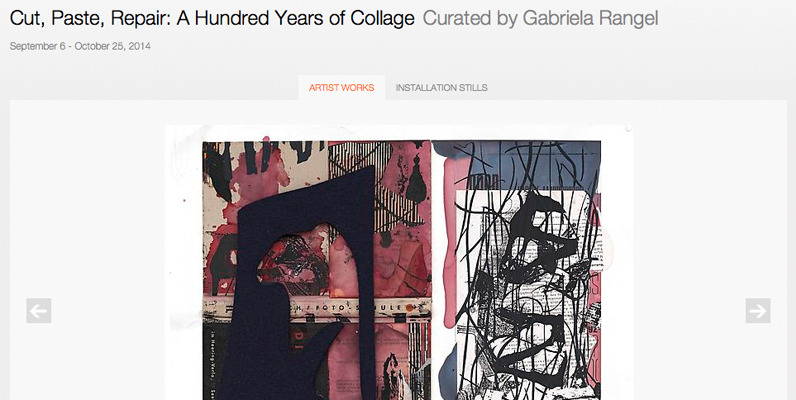Cut, Paste, Repair: A Hundred Years of Collage
Curated by Gabriela Rangel
Kader Attia
Leonora de Barros
Lorenzo Bueno
Ramiro Cháves
Arturo Herrera
Cristóbal Lehyt
LX.
It is to cut your opponent
Just at the moment he cuts you.
This is the ultimate timing.
It is lack of anger.
It means to treat your enemy
as an honoured guest.
Anne Carson (The Fall of Rome: Traveler’s Guide)
One hundred years ago Georges Braque/Pablo Picasso created collage or papiers collés (literally glued papers), which after some years of further development turned into a complex and rather opaque montage technique. It is a fact that the fragment of oilcloth glued on by Picasso in “Nature morte à la chaise can née” painted in May 1912 preceded Braque’s first papier collé entitled “Compotiers et verde,” dated months later the same year. Nonetheless, we will not insist on tireless disputes regarding practical authorship of papiers collés , as these historiographies can often resemble Byzantine quibbles. After its inception in Western art, collage became a powerful means of formal experimentation as well as a revolutionary tool that aimed to depersonalize the act of painting through the use of materials from everyday life, such as newspaper clippings, magazines, cardboard, fabric, wallpaper, sheet music, etc. More importantly, collage proved to be a powerful method of cutting, sticking, and pasting onto a surface to toy with suspension of disbelief, allowing Picasso and after him many other artists to challenge the limits of pictorial illusionism in order to explore and twist the mechanisms of representation (by contrast, decades later Robert Motherwell used collage to evade representation). Photographers such as Hannah Höch and Grete Stern added vitriolic humor and gender wit to collage, bringing new political possibilities (and sensibilities) to an image and its mechanical reproducibility.
If papiers collés were initially used as a formal technique with a disruptive force, they were also born in agitated years, which led the downfall of an aged Austro-Hungarian Empire, scientific and political revolutions, and war. It is not accidental that avant-garde European artists often sought to change the social political consciousness of their time through the use of new formal strategies and conventions that would reflect (and effect) radical transformations that arose from modernity. In the post-war period, Mimo Rotella, Asger Jorn, Robert Rauschenberg, Wolf Vostell, Merce Cunningham, John Cage, Alberto Greco and Alejandro Otero, among others, revamped collage on both sides of the Atlantic with an innovative drive and critical approaches that addressed the exhaustion of painting, as well as the convulsed consequences of mass culture and World War.
Presently collage reverberates in the Global South and in the peripheral North as an incisive yet reparative practice that has the potential of revealing colonial agency, deploring monolingualism, and disavowing hetero-normative attitudes embedded in more and more depoliticized technologically fragmented realities. To cut something is followed by a restorative process, a repair of the object or thing that has been ripped apart and therefore separated from its substance. Cut, Paste, Repair at Sicardi Gallery aims to commemorate the centennial anniversary of collage, a venerable marker of contemporary art with groundbreaking works by Kader Attia (Algeria-France), Lorenzo Bueno (Argentina-U.S.), Lenora de Barros (Brazil), Ramiro Cháves (Argentina-Mexico), Arturo Herrera (Venezuela-U.S.), and Cristóbal Lehyt (Chile-U.S.). All of these artist-bricoleurs propose singular forms of collaging that remain legible, tangible, and still cannot be grasped unless we admit with Serge Gruzinski that: “In theory reparation stops where substitution and replacement begin (…) To repair is therefore also to connect! —! times, people, things …! —! and that’s why any global history of humanity must pay a profound attention to this gesture seemingly simple and commonplace which often consists in inventing a way to insert one world into another, not in a gratuitous manner, but to yield meaning and social manners.”
Gabriela Rangel
Ver / Descargar artículo de fuente primaria
Más información en:
